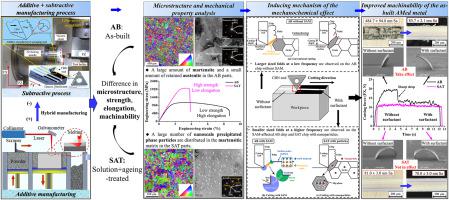International Journal of Machine Tools and Manufacture ( IF 14.0 ) Pub Date : 2023-10-15 , DOI: 10.1016/j.ijmachtools.2023.104086 Yuchao Bai , Yan Jin Lee , Yunfa Guo , Qi Yan , Cuiling Zhao , A. Senthil Kumar , Jun Min Xue , Hao Wang

|
Additive manufacturing technologies are beginning to shift toward hybridization with subtractive processes and it is vital to identify techniques that can enhance the machinability of the difficult-to-cut additively manufactured metals and offer easy integration. The mechanochemical effect, which can be induced by surfactant, is a feasible solution for hybrid integration due to the beneficial enhancements to the cutting performance, online integrability, and negligible impact on the AM process as compared to cutting fluids, cryogenic cutting, etc. To realize the successful integration of the mechanochemical effect and hybrid additive/subtractive manufacturing, micro-cutting of AMed high-strength maraging steel was performed to study the relationship between microstructural features, mechanical properties, cutting performance and effectiveness of the mechanochemical effect. The results show that the mechanochemical effect was successfully induced in the as-built and solution-treated steels by inhibiting dislocation movement to induce the embrittlement of chip surface and strain localization within the chip, thereby leading to substantial reductions in cutting forces of up to 35.24 % and 53.09 %, respectively, with significant improvement in the machined surface quality. However, the presence of 7.7 nm nanoparticles in the age-treated steels renders the mechanochemical effect ineffective in improving machinability. The nanoparticles sharply increased the strength, hardness, and brittleness of the AMed maraging steel where the brittleness replaced the role of surfactant that suppressed plasticity in the chip free surface. The notion was affirmed by the similarities between the cutting chips of the brittle aged steel without surfactant and the as-built steel with surfactant. This study systematically revealed the underlying mechanism of inducing the mechanochemical effect during the micro-cutting of AMed high-strength materials with different microstructures and mechanical properties. More importantly, it is evident that the mechanochemical effect is a highly feasible solution for enhanced hybrid manufacturing, especially for robot-based fabrication works that involve high degrees of freedom and large working ranges but are limited by low mechanical stiffness.
中文翻译:

通过机械化学效应增强增材制造的马氏体时效钢的高效后处理
增材制造技术开始转向与减材工艺的混合,因此找出能够增强难切削增材制造金属的机械加工性并易于集成的技术至关重要。表面活性剂诱导的机械化学效应是混合集成的可行解决方案,因为与切削液、低温切削等相比,它有益于增强切削性能、在线可集成性,并且对增材制造工艺的影响可以忽略不计。为了实现机械力化学效应与混合增减材制造的成功融合,对AMed高强马氏体时效钢进行微切削,研究其组织特征、力学性能、切削性能与机械力化学效应有效性之间的关系。结果表明,通过抑制位错运动,成功地在竣工钢和固溶处理钢中引发机械化学效应,从而引起切屑表面脆化和切屑内应变局部化,从而导致切削力大幅降低高达 35.24 %和53.09%,加工表面质量显着改善。然而,时效处理钢中存在 7.7 nm 纳米颗粒,导致机械化学效应无法有效改善机械加工性能。纳米粒子急剧增加了AMed马氏体时效钢的强度、硬度和脆性,其中脆性取代了表面活性剂抑制无切屑表面塑性的作用。不含表面活性剂的脆性时效钢和含有表面活性剂的竣工钢的切屑之间的相似性证实了这一观点。该研究系统地揭示了不同微观结构和力学性能的AMed高强度材料微切削过程中诱发机械化学效应的潜在机制。更重要的是,机械化学效应显然是增强混合制造的高度可行的解决方案,特别是对于涉及高自由度和大工作范围但受到低机械刚度限制的基于机器人的制造工作。































 京公网安备 11010802027423号
京公网安备 11010802027423号